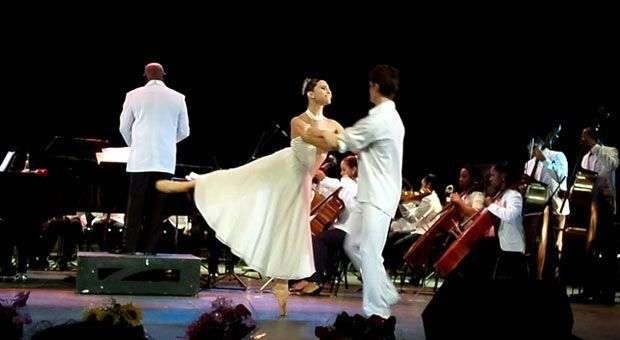Alihaydée Carreño resurfaced in Cuba to reaffirm her class as prima ballerina. Although if you ask her, she danced to give herself a treat, pamper old friends, feel the warmth of her home.
The presence of this ballet diva at a gala music, on September 20 and 21 attracted a host of admirers at Teatro Mella, despite not being a promoted show. The crowd enjoyed her success as the artist took the stage during the four songs that she accompanied. Out of 32 only four, but it was enough to hold all the way to an anxious people.
“Come to the Festival,” begged fans after each gala, while the dancer responded with gestures of distress and helplessness. She wished.
The once first figure the National Ballet of Cuba (BNC) showed that there are no small parts if the talent is great and a torrent of love adorns it. Alihaydée took two ballads, a tango and merengue with the same alacrity of Giselle, a Diana or Odile in Swan Lake. She danced on pointe with the courage of her generation, with mad attitude, poise and delivery that are currently scarce.
The minimum scenario space left by the orchestra of the Cuban Institute of Radio and Television (ICRT) did not impose limits. More than one feared for her life when she set out to run a quick round fouettés (turns on one end with the opposite leg momentum), while she smiled at the destination. Alihaydée belongs to the court of those who always goes out to take it on the stage, she shines, inflames, love.
It is hard to forget the last presentation of Carreño as part of the BNC. The only pas de deux that had been scheduled in the International Ballet Festival of Havana in 2004, was a miracle. The disc with the music of The Corsair just broke when the dancer was on stage for the first time with the Argentinean Leonardo Reale, from the Ballet of the Teatro Colon in Buenos Aires. By the will of the Cuban, away from the traditional way to proceed to order the closing of the curtains, the dancers continued as usual. The sound is completely extinguished and she turns guiding by musical bars, lost track of time. Her fouettés far surpassed the conventional amount. The dancers backstage kept their nerves humming the music as loud as their throats could allow, and tears ran instead of curtains.
Carreno’s generation had the privilege and the challenge of replacing the foundational one of Cuban ballet when Odettes, Kitrys, Swanildas and Giselles stopped being Alicia, Josephine, Mirta, Loipa, Aurora, Marta, Maria Elena, Ofelia, Amparo and Charín. In the 90s of the twentieth century, they were taking the names of Alihaydée Carreño, Lorna Feijoo, Galina Alvarez and Viengsay Valdes, at that time the youngest and the only one left within the national company. Then it was a challenge to dance, because the fact subjected to the pressure of comparisons with some ancestor whose shoes still marked the way ballet had to be danced










